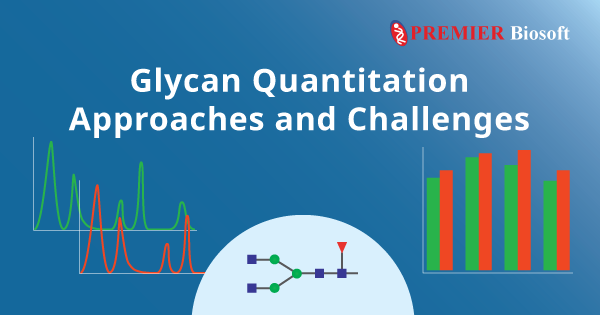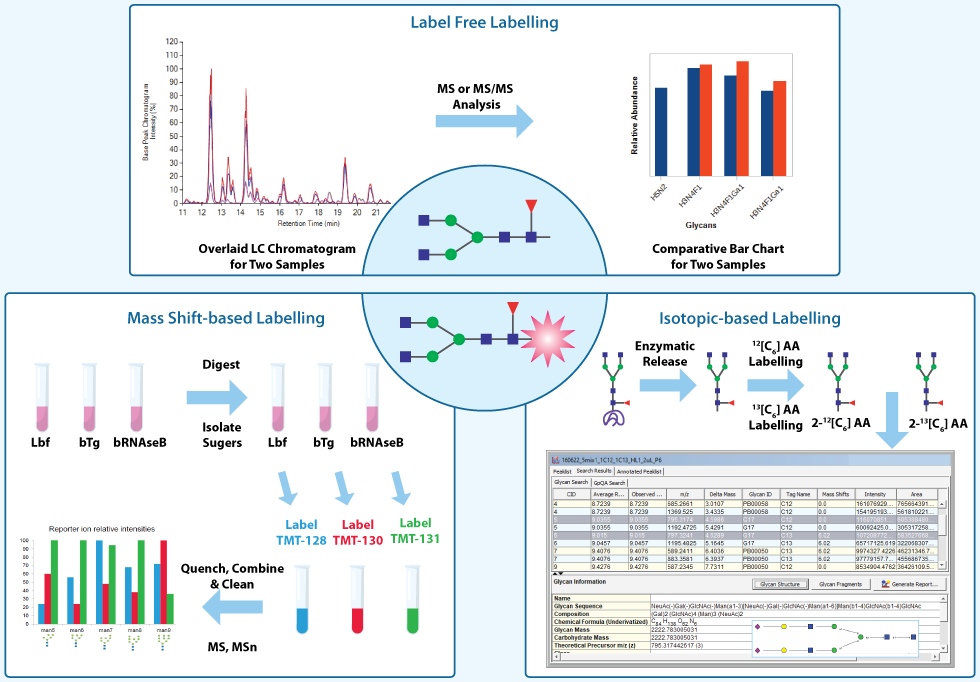Glycan Quantitation - The Approaches and Challenges

March 30, 2022
Glycosylation, one of the most critical PTM, has an influence in the stability, immunogenicity, and clinical efficacy of glycoprotein-based drugs. Studies have revealed that the majority of the eukaryotic proteins are glycosylated. The study of glycans, their localization and the structural pattern, is important for the better understanding of protein regulation, both in healthy and diseased states. Furthermore, identifying the role of glycosylation is important for the efficient production of recombinant proteins and biosimilars. Therefore, the biotherapeutic industries are intensively focused on accurate characterization of glycans through absolute and relative quantitation.
There are two basic methods to quantify glycan abundances:
- Label-free Method
Profiling of the glycans involves both accurate identification of glycans as well as determining their relative abundances. The label-free liquid chromatography coupled mass spectrometry (LC-MS/MS) quantitative approach is a facile and efficient glycan profiling approach. The glycan abundances can be measured using the XIC peak height (absolute intensity) or the area under the curve (AUC) of the compounds of interest, followed by normalization against the sum of intensity/peak areas of the glycans identified. This method can easily compare the expression of glycans across different biological samples run separately.
ChallengesThis label-free quantitation approach works best when all the glycoforms have similar ionization efficiencies. For the glycoforms with different ionization efficiencies, the signal intensities/ peak area may vary between the samples. Therefore the label-free approaches are not a popular choice for quantitative purposes.
In addition, the biggest challenge in this approach is picking the peaks/ compounds efficiently from the raw data. It needs thorough understanding of many factors such as the baseline noise level, acceptable chromatographic peak width, peak height, separation of co-eluting isomers, etc. Apart from these challenges, the processing time is another challenge that glycomics researchers face. A robust and high throughput informatics solution can address all the concerns.
- Labeled Methods
The labeled glycan quantitation methods include:
a. Mass shift-based methods
The mass shift method employs chemically similar but isotopically different tags to derivatize glycan samples, so that they can be distinguished and quantitatively compared by mass spectrometry. In this approach, multiple glycan samples can be analyzed in a multiplexed manner by labeling the samples using stable isotopes such as 12[C6]-2-AA/13[C6]-2-AA. This labeling approach facilitates accurate identification and subsequent quantification of glycans using LC-MS or ESI-MS workflows. This labeling approach can be further modified to the DRAG (Dual Reaction for Analytical Glycomics) workflow, where the reducing end fluorophore and the sialic acids at the non-reducing terminals are methylamidated. Methylamidation improves the ionization efficiency of the sialylated glycans and facilitates easy identification and quantitation of both neutral and sialylated glycans in a single experiment.
Challenges
However, this method requires significant sample handling for glycan purification, derivatization, labeling, and cleanup. Moreover, manual annotation of the glycan structures from each biological sample which are multiplexed is an incredibly tedious and time-consuming exercise. The data analysis challenges can be addressed using an efficient informatics solution that allows defining different biological groups (for example, light, medium, heavy, etc.), each group defined by an isotopic mass shift. This way, multiple glycan samples (tagged with unique combinations of stable isotopes) can be analyzed and further quantified at one go. The XIC peak height or the AUC of the compounds can be used to measure the glycan abundances.
b. Isobaric tags-based methodsIsobaric glycan quantitation using Thermo Scientific™ aminoxyTMT™ (Tandem Mass Tag™) label reagents and Quaternary Amine Containing Isobaric Tag for Glycan (QUANTITY) relies on reporter ions generated in MS2 or MS3. Using the AminoxyTMT reagents, the identification and quantification for up to ten samples can be achieved concurrently, however, QUANTITY supports fourplex analysis. These reagents enable efficient relative quantitation of glycans by improving the labeled-glycan ionization efficiency, thereby increasing analytical throughput. The glycans are quantified by measuring reporter ion peak intensities from the corresponding MS/MS spectra.
Challenges
Although the isobaric methods possess multiple advantages such as improved glycan ionization efficiency, multiplex (up to 10 samples) analysis capability, these methods have limited success. This is because the methods use tertiary amine structure that was originally designed for the quantitation of peptides, not favorable for glycosidic bonds. Furthermore, lack of a high throughput data analysis solution restricts the users to adopt this quantitative approach.
An informatics solution should allow the users to create a labeling method where the samples and their replicates can be attached to the reporter ion channels. It should also take care of the reporter ion correction factors so that the reporter ion signals are adjusted to account for isotopic impurities in each variant. Once the samples and the replicates are tagged with the corresponding ion channels, the abundances of the identified glycans can be measured by calculating the intensity of the reporter ion channels from the tandem MS spectra.
Unlike proteomics, there are no adequate software tools to address the challenges of the above-mentioned glycomics methods. The SimGlycan® software accommodates these quantitation workflows efficiently for rapid and accurate profiling of glycans. To know more about the glycan quantitation workflows, book a meeting with us.

Fig: Schematic glycan quantitation workflows supported in SimGlycan
| Comment | Share |
|


